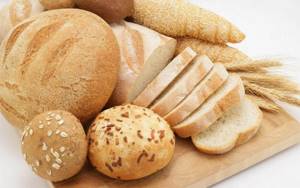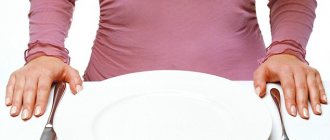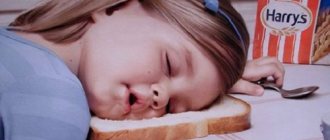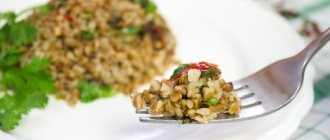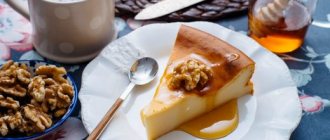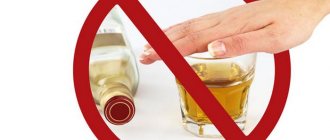To lose weight, you don’t have to go on strict diets or push yourself to the point of exhaustion on exercise machines. It is enough to remove flour and sweets from your diet, and the result will not be long in coming. This is due to the fact that fast carbohydrates are the main source of fat deposits in the body. They are high-calorie foods with a high glycemic index, and therefore, consuming them in large quantities will not help you lose weight.
IT IS IMPORTANT TO KNOW! Fortune teller Baba Nina:
“There will always be plenty of money if you put it under your pillow...” Read more >>
- Show all
The harm of simple carbohydrates
Sugar, bread and other baked goods contain simple, or fast, carbohydrates, which are quickly absorbed by the body, sharply increase blood sugar levels, lead to metabolic disorders and are stored as fat. Nutritionists consider flour, butter and sweet foods to be the most useless for human health, because they contain a maximum of calories and a minimum of beneficial vitamins and microelements.
Thus, the energy value of a bun weighing 100 grams is about 340-370 kcal. In order for the body to expend such an amount of energy, a person will have to work hard on a treadmill or in the gym. Giving up sweets and baked goods is not easy. To make this easier, it is useful to learn about their negative impact on health and figure:
| Weight gain | Regular consumption of bread, confectionery and sweets leads to a gradual increase in body weight. During periods of hormonal imbalance - during puberty, pregnancy or menopause - the situation worsens, and weight problems become obvious |
| Unsatisfactory skin condition | Sweets, pastries, cakes and buns are one of the factors in premature skin aging, as well as the appearance of various rashes, pimples and acne, which teenagers so often suffer from. |
| Risk of developing serious pathologies | If you eat sweets and starchy foods every day, the likelihood of developing diabetes, cancer, heart and liver disorders, atherosclerosis, blurred vision, problems with blood vessels and blood circulation increases. |
| Fatigue and irritability | Sugar causes sudden spikes in blood glucose levels. These chemical reactions lead to causeless fatigue and irritability, sudden mood swings and moodiness. |
| Estrogen and testosterone imbalance | Elevated blood sugar causes the liver to produce an amount of fat that disrupts the ratio of female sex hormones and provokes infertility. |
| Fungal infections | Consumption of sweets often becomes one of the factors in the occurrence of mycoses and candidiasis, therefore, during the period of treatment of thrush or foot fungus, dermatologists advise you to stop eating sweets and flour products |
| Increased appetite | Fluctuations in blood sugar levels cause an unreasonable feeling of hunger and a strong desire to satisfy it with something sweet. Therefore, a vicious circle arises, from which it is difficult to break out - a person gains weight, but cannot help but eat bread and sweets |
By giving up sugar, white flour and foods that contain these high-calorie components, you can easily lose a few kilograms and get rid of extra centimeters on your waist, even without daily jogging or visiting the fitness center. Of course, tangible results will not appear immediately, but the first changes will be noticeable within a month.
All strict diets give a short-term effect, so after returning to a person’s usual diet, he gains kilograms and returns to his previous weight. Excluding sweets, bread and baked goods from the menu has a long-term effect, as the body normalizes metabolic processes and hormonal levels.
Why doesn't this diet work for everyone?
How much weight a person can lose if he gives up sweets and starchy foods depends to a large extent on his state of health. Not everyone can benefit from a diet, since for many people the process of converting fats into energy is impossible due to diseases and metabolic disorders. As a result of this, a person will not only not achieve good results in losing weight, but will also feel very bad.
This occurs due to lack of energy, which causes weakness, headache and dizziness. If such symptoms occur, you should definitely consult a specialist. It is possible that this was due to illness. You will be able to lose weight only after your metabolism and hormonal levels are normalized.
Addiction
Addiction to sweets does happen, but it is not genetically determined. After we eat sweets, excess simple carbohydrates quickly raise blood sugar levels. And after one and a half to two hours it drops below the level that was before the meal, and the body requires “supplements”.
There are a number of diseases in which it will be very difficult to get rid of excess weight, but gaining it, on the contrary, is as easy as shelling pears. The category of such diseases includes pathologies of the cardiovascular system, the presence of benign or malignant tumors, as well as diabetes mellitus. Any disruption of the thyroid gland also affects normal metabolic processes.
If a person is determined to get rid of extra pounds, he must definitely visit a doctor, find out the cause of the disorders in the body and eliminate them. Only after this will diets begin to be beneficial, and there will be no problems with choosing clothes.
It is worth noting that excess weight itself often provokes various ailments. For example, if a person has several tens of kilograms above the norm, this will certainly affect the functioning of the cardiovascular system. Obese people often suffer from shortness of breath, impaired circulation of fluid in the bloodstream and excessive fatigue. In order not to provoke unpleasant symptoms, a person tries to exercise less physical activity, which leads to an even greater increase in body weight.
A psychological factor can also cause obesity. If there are life problems, stress and lack of support from society, a person may begin to eat away his troubles. Thus, due to a violation of psycho-emotional stress, the problem of excess weight arises, which is very difficult to solve.
Diet results and conditions
Judging by numerous reviews, the results of losing weight when giving up sugar, white flour and other foods containing simple carbohydrates vary significantly in each case. This is influenced by various factors:
- initial weight;
- state of human health and the presence of chronic diseases;
- physical activity;
- the presence of additional restrictions, for example, counting and strictly observing the kilocalorie norm, the decision not to eat after 18 hours, etc.
If a person’s body weight does not differ much from the norm, then in the first month you can lose an average of 1.5-2 kilograms. For obese people, these results can be achieved within a week.
In any case, giving up fast carbohydrates will have a beneficial effect on your overall well-being:
In order for the diet to be useful, it is necessary to exclude from the menu not only sugar, but also all foods and dishes that contain it:
- mayonnaise;
- ketchups;
- sweet sauces;
- boiled sausages;
- sausages and sausages;
- semi-finished meat products;
- vegetable and fruit preparations;
- fast food.
Bread and bakery products, pasta (except those made from durum wheat), sandwiches, fast food, chips, candies, chocolate, and confectionery are prohibited.
To ensure that the results of losing weight are not long in coming, you need to help your body get rid of extra pounds. To do this, you must follow several rules.
Drinking regime
Develop the habit of drinking at least 1.5 - 2 liters of clean still water daily. This contributes to the proper functioning of internal organs and normalization of metabolism. But you will have to give up sodas with dyes, packaged juices and alcohol.
Elimination of harmful foods and sweeteners
Kvass and beer cause great harm to the figure: the union of sugar and yeast is a kind of carbohydrate bomb that gives the human body an unattractive volume. Coffee and salt are no less dangerous. They cause retention of excess fluid in the body, increasing the load on the heart, kidneys and circulatory system. Fatty foods are another enemy of weight loss. It harms not only the figure, but the entire body.
The category of harmful products includes any sweeteners and sweeteners - natural and synthetic (stevia, fructose, sucralose, sorbitol, xylitol, aspartame, etc.). Despite the fact that their calorie content is relatively low, they cause the opposite effect when losing weight and contribute to the accumulation of fat reserves in the body.
Regular use of sweeteners is fraught with the appearance of serious diseases: dermatitis, allergies, insomnia, headaches, depression, benign and malignant tumors.
Complex carbohydrates
The daily diet should contain at least 40-60% of foods containing complex carbohydrates:
- fruits;
- vegetables;
- legumes;
- dairy products;
- whole grains and brown bread.
Without enough carbohydrates, a person’s body and mind will not be able to function normally: weakness and dizziness will appear, blood sugar levels will drop, and overall health will deteriorate. A carbohydrate deficiency will cause an irresistible craving to eat something sweet and lead to a breakdown.
It is complex carbohydrates that are a source of vital energy, but do not lead to disruption of metabolic processes and the accumulation of excess fat in the body. Therefore, every day you need to eat a portion of porridge, eat vegetables and fruits.
Protein food
The presence of protein foods in the daily menu is an indispensable condition. Meat, fish, eggs, nuts, seeds, legumes, cottage cheese and dairy products will not only diversify your diet, but will also strengthen your immune system, provide a long-lasting feeling of satiety and help you overcome cravings for flour and sweets.
In addition, the body spends a lot of energy digesting protein foods, which helps burn fat.
Fractional meals
If you give up sweets and starchy foods, you can stick to a traditional diet, which includes breakfast, lunch, afternoon snack and dinner. But it is better to divide the daily amount of products into 5-6 doses every 3-4 hours.
Accordingly, portions need to be reduced. This is very simple to do - use a plate of smaller diameter than usual. A small portion will fit in it, but visually it will seem that there is enough food.
Counting kilocalories
It would be useful to learn how to count the calories entering the body with food. To do this, you can use ready-made tables that indicate the calorie content of basic foods. It is useful to study the energy information listed on the package.
As a basis, you need to take the average number of calories that the body must receive daily for normal functioning. The main indicators for men and women of different age categories are presented in the table:
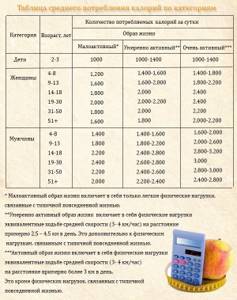
For safe weight loss, it is necessary that the number of calories received is 15% below the specified norm. For example, a 30-year-old woman leading a sedentary lifestyle should consume no more than 1,700 kcal per day (2,000 – 2,000 x 0.15 = 2,000 – 300 = 1,700).
If the daily amount of calories is reduced by 20-40%, the fat deposited on the hips and waist will disappear much faster. But such a strict diet does not leave its mark on the body. It is unacceptable to sharply reduce the amount of energy entering the body, and even more so to consume less than the minimum acceptable level. It can be easily calculated using the formula: current weight of a person / 0.45 x 8
So, a woman with a body weight of 75 kg who decides to lose weight, no matter what lifestyle she leads, needs to receive at least 1333 kcal daily (75/0.45 x 8). When her weight reaches 70 kg, this figure will decrease to 1240 kcal.
Healthy sleep
It has long been proven that fat breakdown is activated during sleep, and chronic lack of sleep is the most common cause of excess weight. Therefore, you need to sleep at least 7-8 hours a day. Healthy sleep will help restore the body's strength, improve the functioning of internal organs and systems, and normalize metabolic processes.
Visualization and morale
Perhaps this is the main point on which the success of your planned weight loss depends. You need to first tune in and prepare for the diet - choose suitable dessert recipes without sugar and flour (banana with cottage cheese, strawberry-raspberry sorbet, fruit salad, candies made from nuts and dried fruits, etc.). Without a thoughtful and complete replacement for flour and sweets, you can break down at any moment.
During a “sugar-flour fast,” it is useful to use the method of visualizing the final result. For this to really work, the next time you want to eat candy or cookies, you need to imagine yourself in a slim body or in your favorite clothes, which have become too small and have long been collecting dust in the closet.
Basic Rules
The basis of the diet from Olga Raz-Kestner is low-calorie bread made from whole flour or with added bran, rye bread or crispbread. This type of bread contains vitamins E, B1, B2, magnesium, phosphorus, calcium, potassium and other useful macroelements. The maximum number of calories allowed is 35-45 kcal in one piece.
When eating bread rich in coarse fibers, there is no sudden release of glucose and insulin; energy is produced more slowly and is consumed by the body gradually. Accordingly, the body will not accumulate any fat deposits in unnecessary places. The main thing is to adhere to simple rules.
- You need to eat small and often (4-5 times a day) and at the same time.
- It is necessary to maintain an interval between meals of 3-4 hours.
- Skipping another meal is strictly prohibited, even if you are not hungry yet.
- It is necessary to maintain a drinking regime and consume at least two liters of fresh drinking water.
- As a last resort, dietary bread can be replaced with regular rye bread at a ratio of 2:1.
Stage 1: active weight loss. During this time, it is allowed to eat low-calorie bread, spreading it with a thin layer of low-fat spread. On the day you need to eat:
- women - 8-12 small pieces;
- men - 12-16 small pieces.
In addition, the menu must include products from the list of permitted ones. The nutritionist recommends combining bread with protein foods and vegetables. The duration of the stage is 14 days.
Stage 2: consolidation of the result. The main goal is not to gain back the lost weight. At this stage, it is necessary to gradually expand the diet, supplementing it with permitted products. The duration of the stage is determined individually. On average - 2-3 weeks.
Allowed products for the first stage of the bread diet:
- sandwiches with low-fat cottage cheese (up to 5%), fish (including salted), lean meat (chicken, turkey, quail, beef, veal);
- ham;
- any vegetables, except those containing starch. This could be cabbage, zucchini, tomatoes, bell peppers, broccoli, asparagus, green peas, various types of lettuce;
- eggs (3 times a week in any form);
- fermented milk products (yogurt, kefir, fermented baked milk) - 200 g per day;
- It is recommended to eat meat or fish with vegetables 3 times a week. On this day, bread consumption should be reduced by 1/3;
- Be sure to consume fruits daily (avocados, apples, plums, pears, etc.);
- It is allowed to use a small amount of vegetable oil for dressing salads;
- green tea, coffee (sometimes), vegetable juices (tomato, carrot, celery juice).
The second stage is characterized by a gradual expansion of the diet. Whole grain bread is gradually being replaced by other products from the list of permitted foods.
Permitted products for the second stage:
- porridge and pasta. It is advisable to choose minimally processed cereals (green buckwheat, brown rice, etc.). So, instead of two slices of bread, you can eat wheat, buckwheat, oatmeal or rice porridge or a small portion of durum wheat pasta;
- potatoes (it is acceptable to consume 1 baked potato per day);
- legumes (lentils and beans);
- the amount of fruit increases (up to three times a day);
- Fermented milk products are still required every day.
Prohibited
The following foods are prohibited while following the bread diet:
- any sweets (honey, sugar, confectionery, candies, chocolate, marmalade) and anything that contains refined sugar;
- smoked meats, pickles, sauces, marinades;
- ketchup and mayonnaise;
- alcohol;
- carbonated drinks;
- preserves and jams;
- any baked goods;
- foods high in animal fats;
- fatty meats;
- fatty fermented milk products (homemade cottage cheese, milk, sour cream).
Since the diet is not particularly varied, nutritionists strongly recommend supplementing it with:
- throughout the course of this nutrition system, take multivitamins and calcium;
- drink plenty of clean drinking water - for women the recommended amount of water is 8-10 glasses a day, for men 10-12.
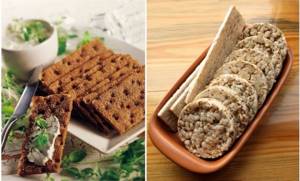
If you follow these simple recommendations, the kilograms will fall off faster, and in return you will receive a boost of vigor and good mood.
And a little about secrets...
The story of one of our readers, Inga Eremina:
I was especially depressed by my weight; at 41, I weighed as much as 3 sumo wrestlers combined, namely 92 kg. How to completely lose excess weight? How to cope with hormonal changes and obesity? But nothing disfigures or makes a person look younger than his figure.
But what can you do to lose weight? Laser liposuction surgery? I found out - no less than 5 thousand dollars. Hardware procedures - LPG massage, cavitation, RF lifting, myostimulation? A little more affordable - the course costs from 80 thousand rubles with a nutritionist consultant. You can, of course, try to run on a treadmill until you go crazy.
And when will you find time for all this? And it's still very expensive. Especially now. Therefore, I chose a different method for myself...
Probably every woman at least once in her life wanted to get rid of a few extra pounds. Trying to limit the daily calorie content of their diet, many people wonder: is it possible to lose weight if you don’t eat bread; reviews and experts do not give a definite answer.
Bread is indeed a fairly high-calorie food product. This is especially true for fresh white bread. However, if you stop using this product, the body stops receiving gluten (gluten). Initially, this can really help you lose weight. Weight loss when giving up bread occurs due to the fact that the total daily caloric intake decreases, but over time such changes in diet can lead to weight gain. Complete refusal of bread for weight loss, reviews do not note good results.
Experts note that gluten deficiency is dangerous because the body will not receive in sufficient quantities all the nutrients necessary for its normal functioning. Wheat flour is a source of fiber, many vitamins, calcium, iron, etc. A lack of these substances can lead to a decrease in energy levels and blood glucose. In addition, due to the lack of carbohydrates, headaches may occur.
If you don't eat bread, can you lose weight? Despite the body's need for the nutrients contained in bread, the calorie content of this product, of course, cannot be denied. Therefore, many nutritionists recommend replacing the usual white bread with whole grain bread. It is much more beneficial for the body with a lower calorie content. However, you should not abuse this product if you are aiming to achieve maximum results in losing weight. Eat a few slices of whole grain bread at breakfast, one at lunch, and try to skip the bread altogether at dinner.
Is it possible to lose weight if you don't eat bread?
Is it possible to lose weight if you don't eat bread? This question is very important, because many women watch their figure and want to lose a little weight. A balanced diet, a healthy lifestyle and just a good mood are the keys to success.
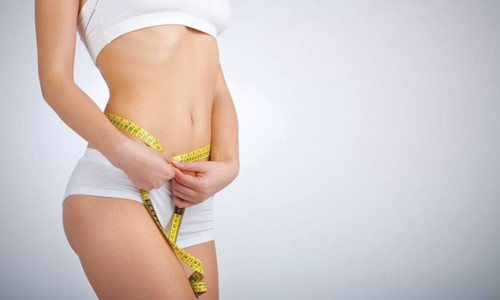
Reasons to give up bread completely
What is bread? In ancient times, bread and salt were considered indispensable products on every table. However, now the morals and worldviews of people have changed. Modern girls are increasingly thinking about their weight and all kinds of diets.
Bread is a staple food product that can be consumed in any form and combined with any dish. Literary sources claim that bread contains a lot of organic substances and B vitamins, the lack of which will lead to weakened endurance, nervousness, and fatigue. However, as we know, all vitamins useful and necessary for human health are found in the grain shell. And with modern technology for processing wheat, only 20% of the beneficial properties remain in bread. Then, is it possible to lose weight if you don't eat bread? Recently, nutritionists are increasingly writing and recommending completely eliminating baked goods from your diet. Most medical professionals believe that a significant portion of diseases develop as a result of fluffy white bread and fluffy golden buns.
Reasons not to eat bread:
Negative aspects of eating bread:
- The healing properties of grain processed using modern technologies are lost. Do we need such useless bread? Flour for grain bread is transformed into powder during the grinding procedure. It is easier for the body to digest such a composition, to become satiated, and it is easier for glucose to enter the blood. This process increases the hormone insulin. Sugar in the blood interacts with proteins in the body and accelerates the aging process.
- Bread contains gluten. The bread dough is sticky. Many people don't even realize they have a gluten allergy. The organ system that protects the body from disease begins to resist the appearance of gluten protein in the body. In turn, this leads to disruption of cerebral circulation, brain functions, and causes cardiovascular diseases.
- Modern agro-industrial enterprises grow productive grain crops. According to experts, wheat is now hybrid, due to the crossing of different genetic forms. The energy value of modern wheat differs significantly from its predecessor. The ratio of useful microelements in wheat decreased to 30%. The human body does not have time to adapt to new changes, which in turn causes a response.
- Most products contain chemicals and preservatives. Bread is no exception to the rule. It contains starch, vegetable fat, corn syrup and sugar, soybean oil and lecithin. What about various baking powders? Are they really that useful?
Despite the amount of energy value, bread does not have many nutrients; much more is found in vegetables and fruits. Before buying bread, read the composition, it will greatly surprise you.
Instructions for use
At the moment, there are many different diets, each of which involves giving up one product or another; there are also those that recommend completely eliminating bread from consumption.
Know that when choosing this method of losing weight, you give up bread and all flour and sweets. Every weight loss begins with the formation of a menu. There is no need to immediately start eating only raw vegetables and water. It is necessary to gradually remove baked goods from your diet. And then completely stop using it for a while. The purpose of this diet is to cleanse yourself and relieve the body of heavy carbohydrates and extra calories. The goal of the diet is to establish a diet that would fully satisfy a person’s nutritional needs with minimal consumption of a particular product. Consider the stages of the bread diet:
- Learn to manage your desires, overcome cravings for foods with a lot of carbohydrates. Start your day with a light breakfast of dairy products and fruits without added sugar. During the day you will not experience a feeling of hunger or heaviness in your stomach. Treat yourself to a cup of coffee or tea with sugar, it will lift your spirits and give you strength. You should eat a hearty meal for lunch so that you don’t have to run around and snack later. Fish, cutlets, chicken are suitable. For a side dish, choose porridge or potatoes, but under no circumstances replace bread with pasta. Drinks include tea with marshmallows or marmalade. In the evening, prepare a balanced, light dinner. Remember! Giving up bread prevents you from overeating on other foods. Cut vegetable salad or cook puree soup. Don't forget to include dairy products in your diet. Between any meal, treat yourself to dried fruits, nuts, fruits, and cottage cheese. Drink kefir or mineral water.
- Don't be lazy and cook for yourself. This way you will know exactly what the dish is made from. Your assistant should be a double boiler, since all products cooked in it retain nutrients. Try to refuse if you are offered something sweet.
- Don't forget about physical activity. They can be light and long, for example, housework, morning jogs, walks, taking the stairs instead of the elevator.
- Control your calorie intake. Make a table of the caloric content of all the foods you eat. Half an hour before meals, drink a glass of cold water to saturate your stomach. And before going to bed, refuse to eat 2 hours before bed.
“I will never part with bread!”
It turns out that if you allow yourself to eat a small piece of bread, you can lose weight.
But it is important to strictly observe consumption standards and choose the right bread. For those who absolutely cannot live without bread, black rye bread is suitable; it is rich and balanced. Even in small doses it will extinguish the feeling of hunger. The daily consumption rate for this product is no less than 150g and no more than 250g. Of course, loaf, white bread, rolls, and pastries should be excluded. Bread with bran and homemade yeast-free bread with hop sourdough are more useful - it has antiviral, choleretic, and hypnotic properties. It also significantly increases appetite and normalizes the monthly menstrual cycle in women. Based on the above, we can conclude that by controlling the consumption of bread, you can not only get rid of extra pounds, but also cleanse the body of biologically active substances of microbial origin. Today there is a very large selection of bread varieties on store shelves. The main thing is to learn to choose correctly.
Diet as prevention
Studies show that people who continuously eat white bread and flour products develop diseases associated with the functioning of the heart, gastrointestinal tract, immune system disorders, and diabetes mellitus worsens much faster.
Interestingly, the development of diseases was not influenced in any way by the fact of heredity, body weight and physical activity. Start your diet today and you will feel lighter, more energetic, more cheerful and have lost extra pounds.
Experiment for a few days and if you feel comfortable, continue weekly.
Women from the forum speak about the effectiveness of a diet without bread: “You just need to overcome yourself at first. I used to eat everything with bread, even pasta. A month later I forgot what bread was!”, “My friend basically doesn’t eat bread, she thinks that it dulls the taste of the dish.
And at the same time she’s losing weight before her eyes”, “Many people believe that eating with bread is not only healthy, but also tasty, just without fanaticism!”, “All my life I’ve been eating bread and devouring all kinds of buns. Now I’m thinking, this isn’t all that healthy,” “The bread diet is good, it helps cleanse the body. But you need to eat bread, the main thing is what kind? When I completely gave up white bread, I came to the conclusion that it helps!”
Is it possible to lose weight without bread and sweets?
Many people are interested in whether it is possible to lose weight if you give up bread and sweets, and how much weight you can lose. Of course, no one knows the exact number of kilograms that you can lose by giving up these products. The result depends on the characteristics of the body and the diet that the person follows. If you give up bread and sweet foods, but your menu includes fried potatoes, sweet cocktails and hamburgers, then you will not see any results. For this reason, in order to get rid of excess weight, it is recommended to give up junk food and familiarize yourself with some rules:
- Switch to fractional meals.
- Drink more fluids.
- Instead of fried foods, eat only stewed or boiled ones.
- Snack on healthy fruits and vegetables.
Also try not to eat a lot at night, drink a glass of low-fat kefir to curb your appetite. Considering the question of whether it is possible to lose weight without bread, reviews note that if you also give up sweets and stick to proper nutrition, you can lose up to 4 kilograms in a month. Although there are also more effective indicators.
How to consolidate the effect
As you know, playing sports in combination with a diet helps accelerate the burning of fat deposits. Many adherents of other nutrition systems complain of lack of strength, weakness and lethargy and cannot resort to physical activity. The bread diet is based on carbohydrates and is quite balanced, so it does not cause feelings of drowsiness or fatigue. It can be combined with light physical activity: walking, Pilates, yoga or dancing.
To prevent the lost kilos from returning, follow your diet: do not eat white bread, continue to drink the required amount of liquid, replace sugar with honey or stevia.
How to eat bread correctly
Many girls are ready to say “no” to sweets, but not everyone is ready to give up bread. It is not necessary to completely exclude it from the diet; it is enough to eat it correctly.
- Nutritionists allow eating no more than two small and thin pieces of bread per meal. Some people ask, can you lose weight if you don’t eat white bread? No, just by giving up the white variety you won’t lose weight, but you should still give it up. You are allowed to eat only whole grain bread.
- Most people who are losing weight are confident that the crust of bread contains few calories compared to the crumb. It's a delusion. The fact is that there is no water in the crust when air and water are present in the crumb. The ideal solution would be to eat bread with milk, since the dairy product contains lysine, which the flour product lacks.
- In order not to gain weight and eat bread, experts recommend combining it with healthy foods. For example, you should give up bread if you are planning to cook pasta, eat sausage, rice, potatoes, fatty cheese and fruit. Try to eat it with salad, milk, and without fat.
- Today you can choose some kind of bread diet, where the main product is gray bread, which contains garlic and basil.
- Healthy types of bread include bran and rye.
Is it possible to lose weight if you give up bread? Reviews do not note high results. The popular expression “Bread makes you fat” forces those who are losing weight to give up this product. On the one hand, the statement is correct, but on the other, not entirely true. The fact is that if you eat only black bread or bread made with whole grains in the first half of the day, then your figure will not suffer.
Diet options
The original diet from Olga Raz-Kestner was gradually modified by fans of the method and, over time, several types of bread diet appeared. Each type is no less effective than the original and has been tested by many women.
Kefir-bread diet
The essence of the diet is that you are allowed to consume one and a half liters of low-fat kefir and no more than 6 slices of bread per day.
A very popular method that allows you to lose 500 grams per day. The disadvantages include the scarcity of the diet, so sticking to such a diet for more than 7 days is not recommended.
Kefir-bread-water diet
The diet includes only kefir, water and bread. During the day you are allowed to drink 4 glasses of low-fat kefir, 8 glasses of water and eat 250 g of whole grain bread. This diet allows you to lose 4-6 kg in 5 days, but it cannot be followed for more than 7 days.
At its core, the bread unit diet is a low-carbohydrate nutrition program recommended for patients with diabetes. The similarity with the method of Olga Raz-Kestner lies only in a varied diet and the possibility of its long-term continuation.
Dietary nutrition is based on calculating the daily intake of carbohydrates. It was for this purpose that German nutritionists introduced a new concept - bread unit (XE).
Usually we consume up to 30 XE per day. In this case, their daily norm should be distributed as follows:
- 3-4 for breakfast, lunch and dinner;
- 1-2 for afternoon snack;
- It is prohibited to consume more than 7 XE per meal;
- The bulk of food containing carbohydrates should be consumed before 12:00.
When compiling a dietary diet, it is recommended to reduce the daily amount of XE to 10. For ease of calculation, there is a table developed by nutritionists.
Table
You can control the glycemic index of foods and monitor the amount of XE consumed using a special table for bread units. If a product is not in the table, it can be consumed without calculation.
| Product | Amount of product in 1 XE |
| apricot (with/without pit) | 130/120 grams |
| quince | 1 fruit or 140 grams |
| pineapple (with peel) | 90 grams |
| orange (with/without peel) | 180/130 grams |
| peanuts with skin | 85 grams |
| watermelon (with rind) | 250 grams |
| banana (with/without peel) | 90/60 grams |
| big mac triple | 1 heh |
| pancakes | 50 grams |
| beans, beans, lentils, soybeans (ripe grains) | 170 grams |
| cowberry | 140 grams |
| elder | 170 grams |
| vareniki | 2 pieces |
| dumplings with cottage cheese | 2-4 pcs |
| grape | 70 grams |
| cherry (with pits) | 12 pieces or 110 grams |
| double hamburger | 3 heh |
| peas (fresh and canned) | 4 tbsp. heaped spoons |
| pomegranate | 1 fruit or 200 grams |
| grapefruit (with/without peel) | 200/130 grams |
| walnuts | 90 grams |
| pear | 90 grams |
| guava | 80 grams |
| diabetic confiture | 25 grams |
| diabetic chocolate | 1/3 tile |
| melon (with rind) | 130 grams |
| blackberry | 170 grams |
| strawberries | 170 grams |
| baked dough products | 50 grams |
| yogurt (any fat content) | 1 cup (250 ml) |
| jacket potatoes | 1 piece |
| boiled or baked potatoes | 70 grams |
| dry potatoes | 25 grams |
| fried french fries | 2-3 tbsp. spoons (12 pcs.) |
| mashed potatoes (water) | 2 tablespoons |
| mashed potatoes (with milk, butter) | 2 tablespoons |
| mashed potatoes (dry semi-finished product) | 1 tablespoon |
| potato fritters | 60 grams |
| potato chips | 25 grams |
| small fries | 1 heh |
| any boiled porridge | 2 tablespoons |
| kvass | 1 glass |
| pine nuts | 60 grams |
| kefir (any fat content) | 1 cup (250 ml) |
| cashew | 40 grams |
| kiwi | 120 grams |
| dumplings | 15 grams |
| strawberry | 200 grams |
| cranberry | 120 grams |
| coca cola, dog cola | half a glass |
| "cornflakes" (muesli) | 4 tablespoons |
| cutlet | 1 medium |
| starch (potato, corn, wheat) | 15 grams |
| crackers (dry cookies, dryers) | 15 grams |
| any raw cereal | 1 tablespoon |
| gooseberry | 150 grams |
| corn | 100 grams |
| corn (cob) | 100 grams |
| canned sweet corn | 60 grams |
| corn and rice flakes (ready-to-eat breakfasts) | 4 tablespoons |
| hazelnuts | 90 grams |
| boiled pasta | 60 grams |
| pasta, dry | 4 tablespoons |
| raspberries | 200 grams |
| mango | 90 grams |
| tangerine (with/without peel) | 160/120 grams |
| honey | 1 tablespoon |
| diabetic honey | 1 tablespoon |
| almond | 60 grams |
| milk (any fat content) | 1 cup (250 ml) |
| carrots (medium) | 200 grams |
| ice cream | 65 grams |
| wholemeal flour, whole wheat grains | 2 tablespoons |
| Rye flour | 1 tablespoon |
| whole soy flour, semi-fat | 4 tablespoons |
| fine flour | 1 tablespoon |
| pancakes | 50 grams |
| breadcrumbs | 1 tablespoon |
| papaya | 140 grams |
| dumplings | 4 pieces |
| frozen dumplings | 50 grams |
| peach | 1 fruit or 140 grams |
| peach nectarine | 1 fruit or 100 grams |
| meat pie | half a pie |
| pizza | 6 heh - 300 grams |
| "popcorn" | 15 grams |
| chocolate pudding powder | 1 tbsp. spoon |
| sprouted wheat | 25 grams |
| curdled milk (any fat content) | 1 cup (250 ml) |
| gingerbread | 40 grams |
| granulated sugar | 10 grams |
| rafinated sugar | 3 pieces |
| beets (medium) | 150 grams |
| condensed milk | 110 ml |
| cream (any fat content) | 1 cup (250 ml) |
| red plums | 80 grams |
| blue plums (with/without pit) | 120/110 grams |
| Red currants | 200 grams |
| black currant | 180 grams |
| soy powder | 2 tablespoons |
| Orange juice | 0.5 cups |
| grape juice | 0.3 cups |
| cherry juice | 0.4 cups |
| grapefruit juice | 1.4 cups |
| pear juice | 0.5 cups |
| cabbage juice | 2.5 glasses |
| strawberry juice | 0.7 cups |
| redcurrant juice | 0.4 cups |
| gooseberry juice | 0.5 cups |
| raspberry juice | 0.75 cups |
| carrot juice | 2/3 cup |
| cucumber juice | 2.5 glasses |
| beet juice | 2/3 cup |
| plum juice | 0.35 cup |
| tomato juice | 1.5 cups |
| apple juice | 0.5 cups |
| salty sticks | 15 sticks |
| sorbitol | 12 grams |
| sausages, boiled sausage | 160 grams |
| noodle soup | 3 tablespoons |
| crackers | 2 pcs. |
| dried fruits (raisins, dried apricots, prunes, figs, dates) | 20 grams |
| cheesecake | 1 medium |
| curd mass with raisins | 40 grams |
| curd sweet mass | 100 grams |
| raw dough: yeast | 25 grams |
| raw dough: puff pastry | 35 grams |
| Jerusalem artichoke | 70 grams |
| pumpkin | 200 grams |
| feijoa | 160 grams |
| pistachios | 60 grams |
| fructose | 12 grams |
| white bread, any rolls (except buns) | 1 piece (20 grams) |
| diabetic bread | 2 pieces |
| wholemeal bread with bran | 1 piece (30 grams) |
| wheat bread for toast | 20 grams |
| Rye bread | 1 piece (20 grams) |
| crispbread | 2 pcs. |
| persimmon | 1 medium fruit |
| cherries (with pits) | 10 pieces or 100 grams |
| blueberry (blueberry) | 170 grams |
| apple (any color) | 1 medium fruit |
We invite you to familiarize yourself with Losing Weight by Blood Composition
Is it possible to eat hot bread?
A hot loaf of bread is a weakness for many. But you should discard such a product, because its main danger lies in the incomplete fermentation process. This will cause irritation of the stomach walls.
But what if you are used to using a toaster or like microwave sandwiches? Bread prepared in this way will not cause much harm. Let’s say in the case of a toaster, the product dries out, which causes the yeast to die. It is also worth noting that if you dry the bread until it becomes crackers, it will not be dangerous for your figure.
How to lose weight without bread?
In order to noticeably lose weight in the shortest possible time, in addition to bread, you will have to give up a number of other products. First of all, this applies to all flour products
, and not just bread. All kinds of puff pastries, buns, pies, pasties, pasta, etc. should now become a strict taboo for you. Exceptions may be products made from wholemeal flour - they are not so high in calories.
You should also give up all sweets
.
Forget about cakes, sweets, pastries, biscuits and other usual desserts. But there is an exception here: from time to time you can eat a few squares of dark dark chocolate. Also avoid fatty and fried foods
. When you see shelves with sausages, sausages, smoked meats, lard, etc. in a supermarket, you decisively walk by. Fried foods, in turn, should be avoided, since such dishes are not only particularly high in calories, but also poison the body with cholesterol.
What ways to prepare dishes?
Steam, boil, stew or bake foods. In this case, you should simmer with a minimum amount of oil, and if possible, then without it at all. If you do not use water, then try to keep this liquid non-greasy and as natural as possible. For example, high-calorie cream is not suitable for us. Store-bought packaged tomato juice is also undesirable, as it contains preservatives and other harmful chemicals. Also refuse various store-bought sauces - mayonnaise, ketchup, etc.
10 diet myths that are harming you
Losing weight has its own mythology. Most girls on a diet unconditionally believe that banana is the most harmful fruit, eating sweets is strictly forbidden, and one glass of dry red wine is good for health. Most often, we owe these beliefs to girlfriends, advice from magazines and the discoveries of “British scientists”. We have collected for you 10 popular myths about diets and weight loss and will explain why they are not true.
Myth 1. A healthy lifestyle is an eternal diet.
In fact: we think that we will face endless self-restraint, no desserts and constant calorie counting. It’s not entirely true: a diet is still considered a temporary restriction of the diet, usually for a specific purpose, for example, to lose two kilograms or improve health. Moreover, most diets usually consist of a strange set of products: buckwheat with kefir, coffee for breakfast, tomato for lunch, and so on. It’s unlikely that you will want to eat like this for the rest of your life, but a healthy lifestyle is not just for a week, it’s forever. Proper nutrition does not imply starvation, but it includes a variety of healthy and tasty foods that you just need to learn how to choose and prepare.
Myth 2. The fewer calories, the healthier the food.
In fact: olive, flaxseed and other vegetable oils contain nearly a thousand calories per 100 g. At the same time, they are considered incredibly healthy, for example, many nutritionists recommend drinking one spoon of olive oil in the morning on an empty stomach. It is also recommended to dress salads with these oils, although they are even higher in calories than lard. High in calories does not always mean harmful. The main thing is to remember that calories should remain in deficit.
Myth 3. Everything you eat after 18:00 will turn into fat.
In fact: anything Cinderella eats will turn her into a pumpkin, as long as it contains excess calories. The appearance of this “legend” is just logical: by the evening you, most likely, have already eaten all the calories you should have, but the body will store the excess as fat. At the same time, the desire to drink tea with cookies or eat something else harmful usually comes closer to night. However, if you have not yet consumed your daily calorie intake by six in the evening, then you may well be able to catch up: there is no direct connection between calories and the time of their consumption. True, this diet is certainly harmful to the stomach.
Myth 4. Fatty foods are evil
In fact: your daily diet should consist of 30% fat. Without them, some fat-soluble vitamins cannot be absorbed, and without them the cells of the body cannot exist. Even the brain is half fat, so don't make fat your main enemy. Without a sufficient amount of fat, our nails and hair deteriorate, our skin dries out, wrinkles form faster, but the absence of fat still does not guarantee slimness. So, instead of manically switching to low-fat foods, calculate your body's daily need for fat and stick to the numbers you get.
Myth 5. There should be no fat on the body.
In fact: such a statement is fraught with anorexia and will not lead to anything good: the presence of a fat layer on our body is simply necessary for the normal functioning of the body. Fat is needed for the functioning of the kidneys, the presence of a fatty layer on the thighs in women is a natural state of affairs, and girls with a low body mass index look starved, and certainly not attractive. To get rid of excess body fat, give yourself cardio exercises, which evenly burn fat in the body where it is really needed. And remember that the places where fat accumulates depend on the individual characteristics of the figure.
Myth 6. Everything sweet is harmful
In fact: sugar is perfectly acceptable in limited quantities. Doctors recommend that women not consume more than 4-5 teaspoons of sugar per day. Keep in mind that we are talking about added sugar, and do not forget that sugar is found in almost everything, including, for example, brown bread, ketchup, mayonnaise, and so on. In the store, look at the labels: fructose, sucrose, maltose, molasses, corn syrup - these are the same sugar, only well disguised. Excess sugar really leads to excess weight, dental problems and a number of diseases, but a piece of dark chocolate, a few apples, a handful of dried fruits or even bananas, which for some reason we are also accustomed to consider a very harmful fruit, are quite acceptable.
Myth 7. Some foods can help you lose weight.
In fact: eating and losing weight, of course, is our old dream. However, you should not blindly believe that pineapple, papaya, grapefruit, garlic and algae magically disappear from our waist. There are no products that directly burn fat. There are diets that will speed up the body's metabolism thanks to a properly designed menu. But a slice of pineapple after a burger won't help.
Myth 8. Healthy food is very expensive.
In fact: unhealthy food is significantly more expensive, especially if you think about the possible consequences in advance. And the healthy menu includes not only asparagus, artichokes and salmon every day. Many healthy foods, on the other hand, are inexpensive and quick to prepare. Remember the existence of healthy legumes (lentils, chickpeas), cereals (barley, bulgur, couscous and regular buckwheat) and seasonal fruits and vegetables. By the way, chicken, useful for any diet, will certainly be cheaper than sliced sausage, fatty boiled pork and cervelat.
Myth 9. Alcohol is beneficial in small doses.
In fact: alcohol is addictive and contains a crazy amount of calories. The legend of a glass of dry red wine appeared to justify our weaknesses. Yes, good wine contains bioflavonoids, but in any case there are fewer beneficial substances in a glass than harmful ones, especially for the liver. Want bioflavonoids? Eat grapes and blueberries, and save alcohol for holiday occasions.
Myth 10. Anti-cellulite creams help you lose weight
In fact: all anti-cellulite and fat-burning gels, creams, ointments and other miraculous remedies will only give an effect in combination with training and proper nutrition. If you just smear yourself with even the most expensive cream and lie down on the sofa, a miracle will not happen. But if you combine cosmetics with physical activity and do it regularly, then improvements in problem areas will actually happen faster than just from training.
Some say that bread is harmful empty carbohydrates, some remember that bread is the head of everything, and some believe that warm bread from a bakery should not be eaten at all. We decided to ask an expert whether to eat bread or not.
Why does this question even arise? There are apparently several reasons.
Menu for 7 days
Olga Raz-Kestner recommends immediately creating a menu for the whole week. This will help you buy the “right” products, avoid breakdowns, and emerge victorious in the fight against extra pounds.
The first stage of the bread diet
When compiling a diet at the first stage, the so-called “vegetable” (4 days a week) and “meat” (3 days a week) days alternate.
Approximate menu for vegetable day
- From 7:00 to 9:00 - drink 1 glass of mineral water. Take calcium and a multivitamin.
- From 9:00 to 11:00 - 4 slices of bread with any permitted spread, grated carrot salad dressed with lemon juice, a cup of green tea or coffee.
- From 12:00 to 14:00 - 1 apple or 200 ml of fermented baked milk, natural yogurt, kefir of your choice.
- From 15:00 to 17:00 - stewed cabbage, 4 slices of bread with any permitted spread, 1 soft-boiled egg, a glass of vegetable juice.
- 16:00 – 18:00 - a glass of water.
- From 17:00 to 19:00 - 4 slices of bread with permitted spread, fresh vegetable salad with herbs, seasoned with 1 tsp. vegetable oil, light vegetable soup. A cup of green tea.
- From 18:00 to 20:00 – a glass of vegetable juice (can be replaced with a glass of mineral water).
- From 19:00 to 22:00 - stewed vegetables, a glass of mineral water.
- From 21:00 to 24:00 - 200 ml of fermented baked milk, natural yogurt, kefir of your choice.
Approximate menu for meat or fish day
- From 7:00 to 9:00 – drink 200 ml of fermented baked milk, natural yogurt, kefir of your choice. Take calcium and a multivitamin.
- From 9:00 to 11:00 - 3 slices of bread with any spread, sauerkraut salad with green onions, a cup of green tea or coffee.
- From 12:00 to 14:00 - 1 orange or 200 ml of fermented baked milk, natural yogurt, kefir of your choice.
- From 15:00 to 17:00 - lean meat or fish, stewed with vegetables in a small amount of vegetable oil, a glass of vegetable juice.
- 16:00 – 18:00 - a glass of water.
- From 17:00 to 19:00 - 3 slices of bread with spread, vegetable soup, steamed or boiled cauliflower, a cup of tea.
- From 18:00 to 20:00 – a glass of vegetable juice (can be replaced with a glass of mineral water).
- From 19:00 to 22:00 - stewed vegetables (vegetable stew or saute), a glass of mineral water.
- From 21:00 to 24:00 - a glass of water or unsweetened tea.
Second phase
The goal of the second stage is a gentle exit from the diet and consolidation of the results. At this stage, bread snacks are gradually replaced by the following dishes:
- durum wheat pasta;
- a portion of porridge (wheat, rice, buckwheat, bulgur) without additives;
- 1-2 boiled or baked potatoes;
- boiled beans or lentils (1 cup);
- boiled corn (1 cob);
- 2-4 tablespoons of oatmeal or muesli (possible with low-fat milk).
Fashion for low-carb diets
When we eat bread made from whole grain flour, there are no sharp spikes in insulin (unlike eating bread made from premium wheat flour), which means that we feel fuller longer.
Here is an example of ingredients for something healthy that you can prepare at home in the oven:
- 450 g whole grain flour (preferably half rye and half wheat);
- ¾ teaspoon of soda;
- 1 teaspoon salt;
- 375–400 g kefir.
Knead the dough and bake in the oven.
Healthy bread recipes ^
Experts say that bread can be healthy. The main thing is to be able to choose the right bread, which will be healthy for the body, rich in vitamins, proteins and other useful substances. When choosing bread, nutritionists advise choosing the one that has the least calorie content, that is, it has lower energy value.
These types of bread can be:
- white bread made from wheat flour - 300 kilocalories per 100 grams;
- white bread with bran - 250-270 kilocalories per 100 grams;
- rye bread – 180-190 kilocalories per 100 grams;
- whole grain bread – 160-180 kilocalories per 100 grams;
- bread - 13-22 kilocalories per 1 loaf.
Is it really impossible to eat hot bread that has just been baked?
It is better to eat bread chilled, since in this case the starch that forms its basis acquires a special structure and becomes resistant. It, unlike its hot counterpart, is digested slowly and little and in this respect is more like fiber. Simply put, it's healthier. The same applies to the beloved by many.
| Bread and diet are seemingly incompatible concepts. Weight loss experts advise banishing all flour from your table like demons. However, not everyone is ready to give up baked goods for the sake of being slim. Are there diets that do not prohibit flour? Experts disagreed for a long time and, probably, for a long time.
[td] |
BREAD: BENEFITS
[/td]
Prepared from grains, mostly refined, containing salt, soda, yeast, lard and other additives, subjected to high temperature treatment, and then consumed daily 3-4 times a day, and even in large quantities, and indiscriminately combined with other products, - bread is one of the most harmful foods.Non-whole grains (flour) do not contain vitamins and minerals,
minerals are found in the skin of the grain, but bread does not contain it. When grain is threshed and turned into flour, organic salts are removed. No amount of “enrichment” of flour will return its natural vitamins.
Bread is an important source of valuable vegetable protein, containing a number of essential amino acids.Bread is a significant source of B vitamins. It serves as a daily source of plant fiber.
Finally, bread is a source of minerals necessary for the body, namely potassium, calcium, magnesium, sodium, phosphorus, and iron.
Of course, you won’t find as many vitamins and minerals in regular bread! Choose whole grain breads, yeast-free breads, crispbreads and sprouted grain breads.
Harm of bread in combination with other products
Eating too much bread, even without other foods, is known to ruin your health.
But combining it with meat causes even more harm!
The benefits of bread in combination with other products
Bread goes well with dairy and fermented milk products, for example, kefir, milk or hard cheese.
And, of course, it goes well with vegetable dishes and soups.
Harm of yeast bread
Yeast bread
reduces immunity, thereby causing various diseases.
By consuming yeast bread, we turn our gastrointestinal tract into a battlefield between the yeast contained in it and the natural intestinal microflora. And this can lead to dysbiosis.
The benefits of yeast-free bread
Unleavened bread or bread with hops
- a good alternative to yeast bread for dysbiosis and fungal infections of the intestines, when excess microflora is undesirable and sometimes destructive. And salt-free bread is a solution for hypertension and kidney disease.
The harm of white bread
Shelton says a child should not be given bread
and cereals in general!
Wheat
- the most harmful cereal in terms of acidity. Excess acidic foods deprive the body of calcium.
White bread is the main cause of tooth decay.
If you want you and your children to have healthy teeth, eliminate white bread and cereals from your diet.
Studies have shown that peoples whose diet does not include grains have teeth and oral cavity in ideal condition.
The benefits of bran bread
Eating bran bread
useful not only for its energetic properties, but also for
its cleansing properties.
Large pieces of grains are a natural “peeling” for the gastrointestinal tract.
Bran does not add energy value to bread, but is removed from our body in an undigested form, playing the role of a purifier. In addition, bran creates volume in the stomach and provides a feeling of fullness.
Bread is not particularly valuable
Bread has no value for humans and is not necessary for health and life.
Cereals can only be consumed in their unprocessed form.
Cereals and bread are not the basis of nutrition, as previously thought. Look today.
Bread
There is also such a unique product as grain bread.
There is also fitness bread, bran bread with nuts and seeds. If you eat bread with seeds, then on this day it is better to refuse seeds.
Bread is difficult to digest
This is a heavy food for children and adults; bread ferments easily and causes a lot of gas and intoxication.
The benefits of sprouted grain bread
Eat yeast-free bread made from sprouted wheat
— there are carbohydrates, minerals, and vitamins!
The wheat germinates, grind it in a meat grinder, make a flat cake 0.5 cm thick and bake it in melted butter. It remains raw in the middle - it’s both tasty and healthy!

Diet for losing belly fat without wheat - basic principles
You can eat in unlimited quantities:
• vegetables (except potatoes and corn), including herbs and mushrooms
• roasted nuts and seeds
• fats – olive oil, avocado oil, peanut oil
• eggs, poultry (chicken and turkey, preferably free-range), beef, pork, venison, fish, shellfish
• cheese
• sugar-free seasonings - mustard, horseradish, salsa, mayonnaise, various types of vinegar, soy sauce, chili sauce and paprika
• avocados, olives, coconuts, spices, cocoa (unsweetened)
You can eat in moderation:
• dairy products (milk, yogurt, butter, cottage cheese)
• fruits - the best berries (blueberries, raspberries, blueberries, strawberries, cranberries), cherries, bananas
• corn (do not confuse them with cornmeal, which should be avoided)
• cereals: millet, sorghum, amaranth, buckwheat, rice (brown and white), oats
• legumes and tubers - all varieties of beans, lentils, chickpeas, potatoes
• soy products - tofu, tempeh, miso, soybeans
Avoid these foods completely:
• wheat products - bread, pasta, cookies, cereals, pancakes, waffles
• products made from rye and barley
• unhealthy fats - fried foods, hydrogenated, polyunsaturated (especially corn, sunflower, grape seed and soybean oils)
• those foods that contain a lot of gluten: corn, rice flour, potatoes or tapioca (they also have a high GI)
• dried fruits - figs, dates, prunes, raisins and cranberries
• fried food
• fructose-based sweets and sweeteners - honey, maple syrup, high fructose corn syrup, sucrose
• sweet desserts - such as jam,
• ketchup (if it contains glucose-fructose syrup)
You can find any diet for weight loss for free , but any of them will have restrictions on bread and flour products. So why bother yourself if it is enough to follow a simple diet to lose belly fat, excluding products containing wheat.
Take the survey to see how you feel about the wheat-free diet:
[yop_poll id=”3"]

How to cook beef khashlama. Georgian cuisine
Previous post
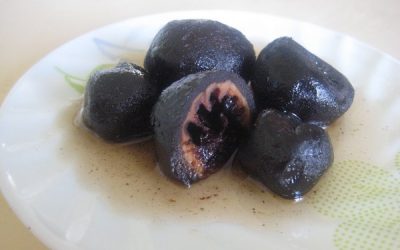
How to make walnut jam
Next entry
Do you eat bread?
The truth is in the middle: what matters is the quality of the bread, the freshness and, of course, your attitude. There are ladies who are confident that eating a bun will immediately put on weight. And this mood is read by the body as a guide to action: the brain said to gain weight, which means we will gain weight. Others see no harm in eating a slice of Borodinsky at lunch - and their confidence in caloric infallibility is again reflected in the consequences.
Before deciding whether to eat bread while dieting or not, decide on the side. What role do baked goods play in your life? If the world is not nice to you without a piece of your favorite grain, why endure such deprivation? It is important to take into account all subconscious throwing and, if necessary, engage in auto-training. Read in the morning like a mantra: “I won’t get fat from a piece of bread.”
What kind of bread can you eat on a diet?
- Here nutritionists have no doubts - only from whole grain flour or containing bran. Options with flax, sesame and sunflower seeds are very useful. But wheat loaves made from premium flour are the main enemy of all those who are losing weight, and the cat is missing out on the vitamins in them. Experts call them “calorie bombs” - useless and destructive.
- Second gradation – purchased or homemade? The answer is already clear from the question - naturally, products prepared with one’s own hands are higher in both quality and benefits. And there is much less chemistry in them!
- If you really can’t live without bread, buy a bread machine and create your own masterpieces.
Pay special attention to the choice of flour - take peeled and wallpaper, preferably marked “bio” (it was grown naturally). Some adherents of eco-food grind their own flour from grain purchased in farm stores. To fortify the product, add flax or sesame seeds, nuts, herbs, onions or carrots to the dough.
Glycemic index of bread
It’s worth going to the bread department of any supermarket, and it immediately becomes clear that there are a great many varieties of bread. And not every one of them is useful. Sometimes a person notices that one kind of food fills you up for a long time, while another type fills you up only for a couple of hours.
This happens because different types of foods have different glycemic indexes. This indicator tells you how long it will take for the food you eat to be digested. And the longer it takes to digest, the longer the body feels full.
| Type of bread | Glycemic index |
| White | 85 |
| Black | 51 |
| Borodinsky | 44 |
| Black with seeds | 49 |
| With bran | 50 |
When choosing what kind of bread you can eat while losing weight, you should definitely exclude white bread. All products made from premium wheat flour have a high glycemic index - about 85. And white bread is no exception.
Do your children need bread?
Bread has its opponents and defenders.
Once one mother on the playground objected to me that “how come you don’t give bread to your child?
Bread is very healthy!” To which I remained silent. Meanwhile, bread leads to tooth decay! And you can’t get vitamins and minerals from regular flour. There are better choices - grains, fruits and vegetables. By the way, various buns, pizza, cookies, rolls, and ready-made breakfasts can also be classified as harmful foods. Of course, I am not trying to eliminate flour products from my child’s diet at all.
But at least I limit it! My family sometimes eats bran bread and crispbread. Do you eat bread?
Calorie content
When creating a diet menu, it is important to consider the number of calories in the type of bread. When choosing, you need to remember not only about the beneficial properties. Thus, you can understand how much and what type of bread to eat so as not to gain weight.
| Product | Kcal per 100 grams |
| White wheat | more than 230 kcal |
| Rye bread | 210 - 220 kcal |
| Wholegrain | 230 kcal |
| Bran bread | 250 kcal |
| Buckwheat bread | 180-200 kcal |
| Bakery | 400 kcal |
Therefore, the best time to include bread in the menu is the first half of the day, then the energy will have time to be spent.
